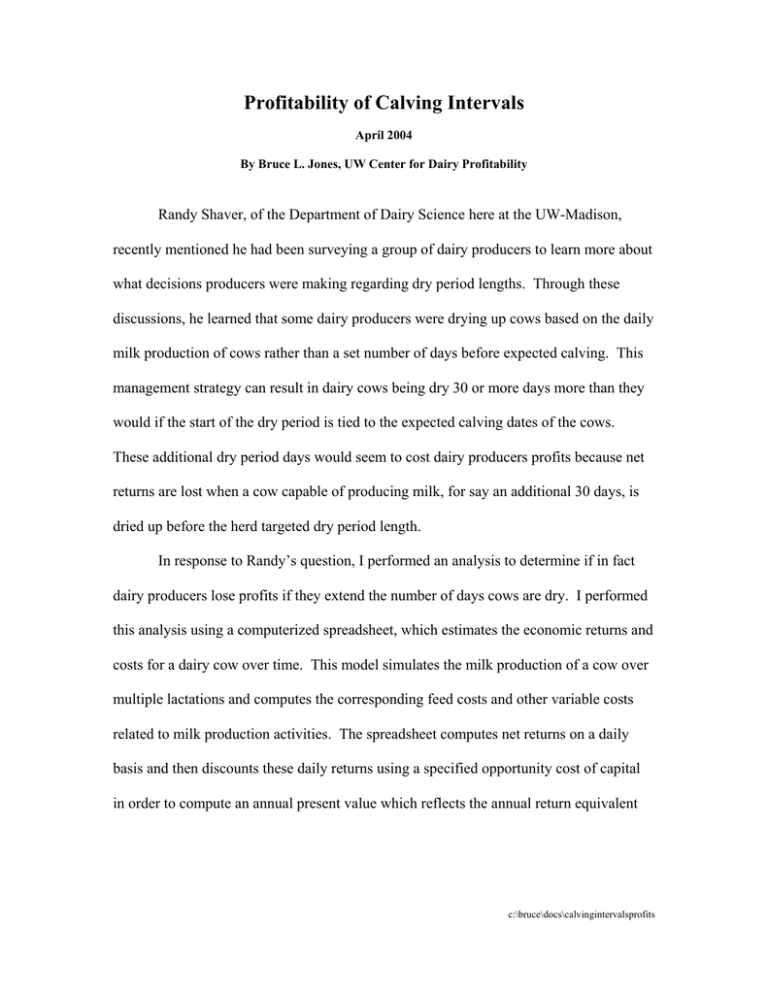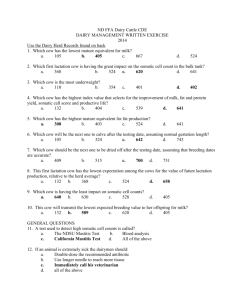Profitability of Calving Intervals
advertisement

Profitability of Calving Intervals April 2004 By Bruce L. Jones, UW Center for Dairy Profitability Randy Shaver, of the Department of Dairy Science here at the UW-Madison, recently mentioned he had been surveying a group of dairy producers to learn more about what decisions producers were making regarding dry period lengths. Through these discussions, he learned that some dairy producers were drying up cows based on the daily milk production of cows rather than a set number of days before expected calving. This management strategy can result in dairy cows being dry 30 or more days more than they would if the start of the dry period is tied to the expected calving dates of the cows. These additional dry period days would seem to cost dairy producers profits because net returns are lost when a cow capable of producing milk, for say an additional 30 days, is dried up before the herd targeted dry period length. In response to Randy’s question, I performed an analysis to determine if in fact dairy producers lose profits if they extend the number of days cows are dry. I performed this analysis using a computerized spreadsheet, which estimates the economic returns and costs for a dairy cow over time. This model simulates the milk production of a cow over multiple lactations and computes the corresponding feed costs and other variable costs related to milk production activities. The spreadsheet computes net returns on a daily basis and then discounts these daily returns using a specified opportunity cost of capital in order to compute an annual present value which reflects the annual return equivalent c:\bruce\docs\calvingintervalsprofits for a dairy cow for a specific set of assumptions regarding: milk production; milk price; calf sales; feed costs; variable production costs; labor costs; etc. For the purpose of this analysis the calving interval for a dairy cow was set at 395 days (approximately 13 months) and the length of the dry period as set at either 40 days or 70 days. The 70 day dry period was assumed to reflect what would occur if a dairy producer dried up a cow based on a targeted level of daily milk production. In contrast the 40 day dry period was assumed to reflect the case where a cow is dried up based on her expected calving date. A set of base assumptions were made about milk price, feed costs, other direct production costs, labor costs, etc to perform this analysis. These specifications, some of which are summarized in Table 1, were used in estimating the expected net returns associated with the two dry periods being considered in this analysis. This is an important point because it means any differences in the net return for the two dry periods are directly attributable to the differences in the lengths of the two dry periods. TABLE 1 Key Assumptions Used in the Analysis Milk Price $11.97 per cwt Forage $150 per ton Corn $2.60 per bu Soybean Meal $280 per ton c:\bruce\docs\calvingintervalsprofits The previously discussed spreadsheet model was used to estimate the net annualized returns for both 40 day and 70 day dry periods when the annual opportunity cost of capital is 5 percent. Net annual returns were estimated for a high level of milk production (approximately 30,000 pounds for 305 days milking) and for a more modest level of milk production (roughly 24,000 pounds for 305 days milking). These different levels of milk production were considered to determine if there may be a greater incentive to extend the length of a cow’s dry period if the cow is producing at a relatively high level. The values presented in Table 2 are the results that were obtained for the case where the dairy cow is assumed to be producing roughly 30,000 pounds of milk over the first 305 days of a lactation. For this case, the net annual returns for a 70 day dry period were consistently less than those for a 40 day dry period. Roughly $150 per year per cow is lost by extending the dry period 30 days for the first lactation of a multiparous cow and the loss rises to about $180 per year for a cow in her fourth lactation. These results clearly show that economic losses are incurred when dairy producers extend the dry period of cows from 40 days to 70 days. The values in Table 3, which correspond to 24,000 pounds of milk production over 305 days, show that losses are also incurred when the dry period of a cow producing at a more moderate level is extended 30 days. These losses are $60 to $80 less than those reported for the higher producing cow in Table 2 because less potential income is lost during the dry period when a cow is producing at a rate of 24,000 pounds versus 30,000 c:\bruce\docs\calvingintervalsprofits pounds over 305 days. Even though those losses are smaller, they are still losses a dairy producer would want to avoid. Thus it makes no sense for a dairy producer to extend the dry period at this lower level of milk production. CONCLUSIONS The results of the analysis discussed here clearly show that dairy producers should generally not be drying up cows just because the daily milk production of the cows is dropping below some target level. It has been show here that this management practice will cause dairy producers to lose potential profits. For high producing cows (30,000 pounds of milk for 305 days milking) these losses can be in the range of $150 to $180 per cow. Similarly losses can be in the range of $80 to $105 per cow for herds milking at a rate of about 24,000 pounds of milk for 305 days. These losses can be even greater when milk prices are above the $12 level used in their analysis or feed prices are less than those specified for this analysis. It is critical that dairy producers understand that extending the dry period of a cow just because a cow’s daily milk production is down in the area of 50 pounds of milk per day is not a profitable action. Even at this low level of milk production, milk returns still generally exceed the costs of producing milk. As such positive net returns are still gained from keeping the cow in production in the latter stages of a lactation. This is important because it means dairy producers should be trying to keep dairy cows producing milk as long as they can before it eventually becomes necessary to dry up the cow so that she can get in condition to calve and begin a new lactation cycle. c:\bruce\docs\calvingintervalsprofits Table 2: Net Returns ( In $ ) For a Dairy Cow, Over a 395 Day Calving Interval, Producing at a Level of About 30,000 Pounds of Milk (*) For The First 305 Days of a Lactation Difference in Net Number of Days Dry: Returns Lactation 40 70 1 1483.72 1333.83 149.89 2 1742.66 1573.17 169.49 3 1872.41 1693.11 179.30 4 1906.46 1724.57 181.89 (*) Daily milk production at 325 and 355 days in milk were 78.46 pounds and 75.62 pounds, respectively. c:\bruce\docs\calvingintervalsprofits Table 3: Net Returns ( In $ ) For a Dairy Cow, Over a 395 Day Calving Interval, Producing at a Level of About 24,000 Pounds of Milk (*) For The First 305 Days of a Lactation Difference in Net Number of Days Dry: Returns Lactation 40 70 1 772.00 687.67 84.33 2 970.01 871.97 98.04 3 1069.23 964.33 104.90 4 1095.26 988.56 106.70 (*) Daily milk production at 325 and 355 days in milk were 55.13 pounds and 52.30 pounds, respectively. c:\bruce\docs\calvingintervalsprofits




